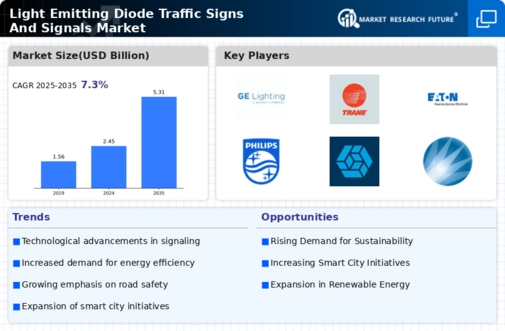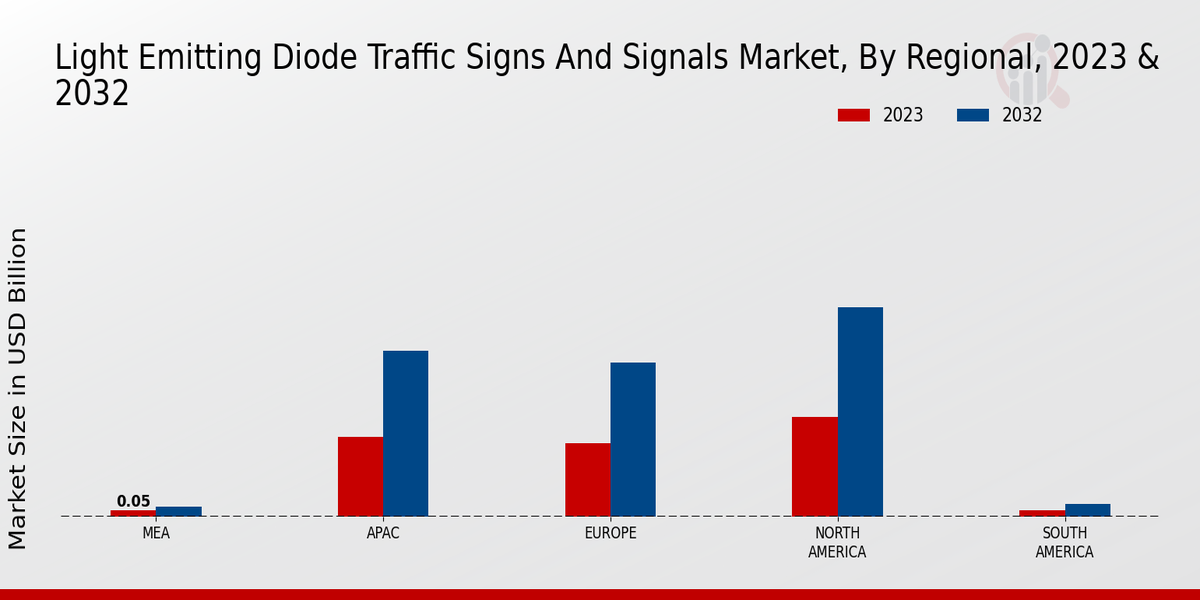Market Growth Projections
The Global Light Emitting Diode Traffic Signs And Signals Market Industry is poised for substantial growth, with projections indicating a market value of 2.45 USD Billion in 2024 and an anticipated increase to 5.31 USD Billion by 2035. This growth trajectory suggests a compound annual growth rate (CAGR) of 7.29% from 2025 to 2035. Such figures reflect the increasing adoption of LED technology in traffic management systems globally, driven by factors such as energy efficiency, technological advancements, and regulatory support.
Rising Demand for Energy Efficiency
The Global Light Emitting Diode Traffic Signs And Signals Market Industry is experiencing a notable shift towards energy-efficient solutions. With the increasing emphasis on sustainability, municipalities are adopting LED traffic signs and signals due to their lower energy consumption compared to traditional lighting technologies. For instance, LED systems can reduce energy usage by up to 80 percent, which not only lowers operational costs but also contributes to environmental conservation. This trend is expected to drive the market's growth, with projections indicating a market value of 2.45 USD Billion in 2024, reflecting the growing preference for energy-efficient traffic management solutions.
Public Awareness and Safety Concerns
Growing public awareness regarding road safety and the effectiveness of traffic management systems is influencing the Global Light Emitting Diode Traffic Signs And Signals Market Industry. Citizens are increasingly advocating for improved traffic safety measures, prompting local governments to invest in advanced signaling technologies. LED traffic signs are recognized for their superior visibility and ability to convey information quickly, which can significantly reduce accidents. As public demand for safer roadways continues to rise, municipalities are likely to prioritize the installation of LED traffic signals, thereby fostering market growth.
Government Initiatives and Regulations
Government initiatives aimed at enhancing road safety and reducing energy consumption are significantly influencing the Global Light Emitting Diode Traffic Signs And Signals Market Industry. Many countries are implementing regulations that mandate the use of LED traffic signals in urban areas. For example, the U.S. Department of Transportation has been promoting the adoption of LED technology to improve visibility and reduce maintenance costs. Such policies not only encourage municipalities to upgrade their traffic management systems but also create a favorable environment for market growth. This regulatory support is expected to sustain the market's expansion, with a CAGR of 7.29% projected from 2025 to 2035.
Urbanization and Increased Traffic Volume
The rapid pace of urbanization is a critical driver for the Global Light Emitting Diode Traffic Signs And Signals Market Industry. As urban populations grow, the demand for efficient traffic management systems intensifies. Increased traffic volume necessitates the implementation of advanced traffic signaling solutions to ensure safety and minimize congestion. LED traffic signs and signals offer enhanced visibility and responsiveness, making them suitable for densely populated areas. This growing urbanization trend is likely to bolster the market, as cities seek effective solutions to manage their expanding transportation networks, further driving the adoption of LED technologies.
Technological Advancements in LED Technology
Continuous advancements in LED technology are propelling the Global Light Emitting Diode Traffic Signs And Signals Market Industry forward. Innovations such as smart traffic signals, which adapt to real-time traffic conditions, enhance road safety and efficiency. These developments are complemented by improvements in LED lifespan and brightness, making them more reliable and effective for urban environments. As cities increasingly integrate smart technologies into their infrastructure, the demand for advanced LED traffic solutions is likely to rise. This trend is expected to contribute to a projected market size of 5.31 USD Billion by 2035, indicating a robust growth trajectory.























Leave a Comment